My Mother’s Peasant Bread: The Best Easiest Bread You Will Ever Make
This post may contain affiliate links. Please read my disclosure policy.
This is the no-knead bread recipe my mother has been baking for 45 years. Start to finish, it can be ready in three hours. It bakes in well-buttered Pyrex bowls — no need to preheat a baking vessel for this recipe — and it emerges golden and crisp with a soft, tender crumb. 🍞🍞🍞🍞🍞
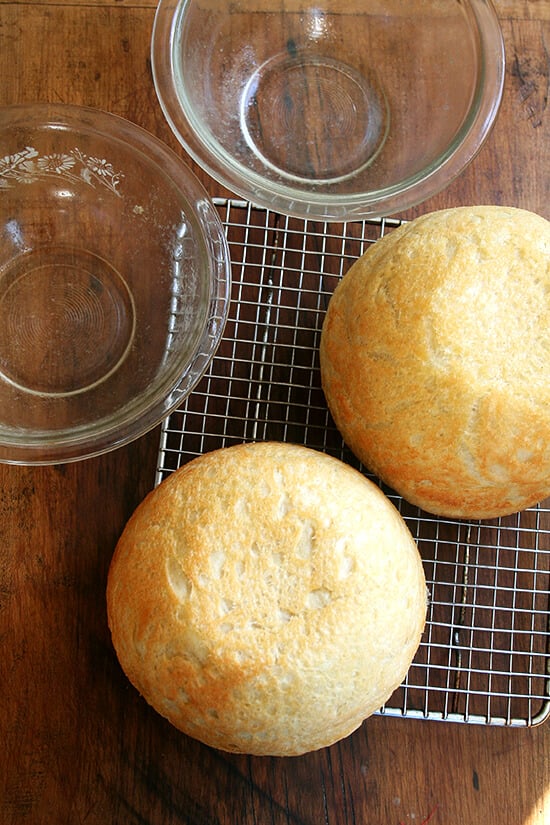
When I tell you that, if forced, I had to pick one and only one recipe to share with you that this — my mother’s peasant bread — would be it, I am serious. I would almost in fact be OK ending the blog after this very post, retiring altogether from the wonderful world of food blogging, resting assured that you all had this knowledge at hand. This bread might just change your life.
The reason I say this is simple. I whole-heartedly believe that if you know how to make bread you can throw one hell of a dinner party. And the reason for this is because people go insane over homemade bread. Not once have I served this bread to company without being asked, “Did you really make this?” And questioned: “You mean with a bread machine?” But always praised: “Is there anything more special than homemade bread?”
And upon tasting homemade bread, people act as if you’re some sort of culinary magician. I would even go so far as to say that with homemade bread on the table along with a few nice cheeses and a really good salad, the main course almost becomes superfluous. If you nail it, fantastic. If you don’t, you have more than enough treats to keep people happy all night long.
The Magic of the Peasant Bread
So what, you probably are wondering, makes this bread so special when there are so many wonderful bread recipes out there? Again, the answer is simple. For one, it’s a no-knead bread. I know, I know. There are two wildly popular no-knead bread recipes out there.
But unlike the others, this is a no-knead bread that can be started at 4:00pm and turned out onto the dinner table at 7:00pm. It bakes in well-buttered Pyrex bowls — there is no pre-heating of the baking vessels in this recipe — and it emerges golden and crisp without any steam pans or water spritzes. This is not artisan bread, nor is it trying to be. It is peasant bread, spongy and moist with a most-delectable buttery crust.
Genuinely, I would be proud to serve this bread at a dinner party attended by Jim Lahey, Mark Bittman, Peter Reinhart, Chad Robertson, Jeff Hertzberg and Zoe Francois. It is a bread I hope you will all give a go, too, and then proudly serve at your next dinner party to guests who might ask where you’ve stashed away your bread machine. And when this happens, I hope you will all just smile and say, “Don’t be silly. This is just a simple peasant bread. Easy as pie. I’ll show you how to make it some day.”
Peasant Bread Variations
Once you master the peasant bread, you can make any bread your heart desires — this simple no-knead bread recipe is the foundation of many of the other bread recipes on this site, namely this hugely popular overnight refrigerator focaccia and this simple homemade pizza dough. It’s even the inspiration behind this sourdough focaccia and this sourdough sandwich bread and this simple pita bread recipe.
The below post is organized as follows:
- How to Make Peasant Bread, Step by Step
- The Best Way to Store Bread
- Peasant Bread Dinner Rolls
- Peasant Bread Sandwich Bread
- How to Add Seeds and Nuts to Bread Dough
- How to Make Gluten-Free Peasant Bread
- How to Coat the Loaves in Seeds
- How to use Whole Wheat Flour
- How to Bake the Peasant Bread in a Dutch Oven
Many more variations on the peasant bread can be found in my cookbook, Bread Toast Crumbs:
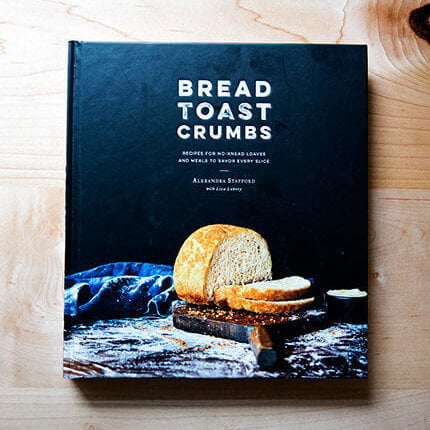
Bread Toast Crumbs
Love the peasant bread? There’s now a book filled with 40 simple bread recipes plus 70 recipes to use up every crumb of every loaf you bake.
How to Make Peasant Bread, Step by Step
First: You need yeast.
This is the yeast I buy exclusively: SAF Instant Yeast. Instant yeast can be whisked into the flour directly without any blooming or proofing. If you want to stick to active-dry yeast, there are instructions in the recipe notes on how to do so. Red Star yeast is great.
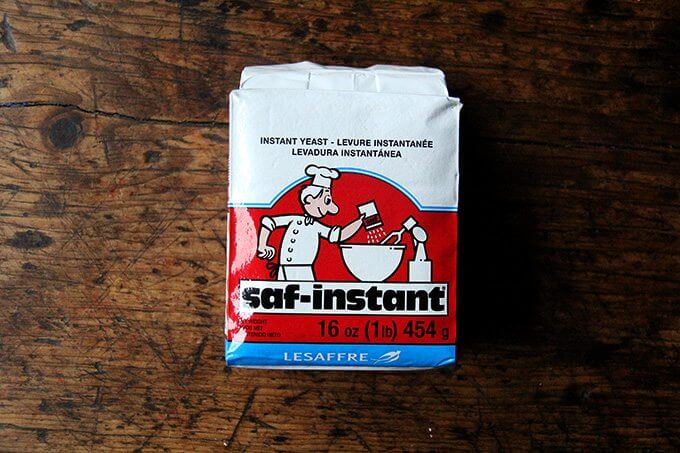
Whisk together flour, salt, sugar, and instant yeast. Add lukewarm water.
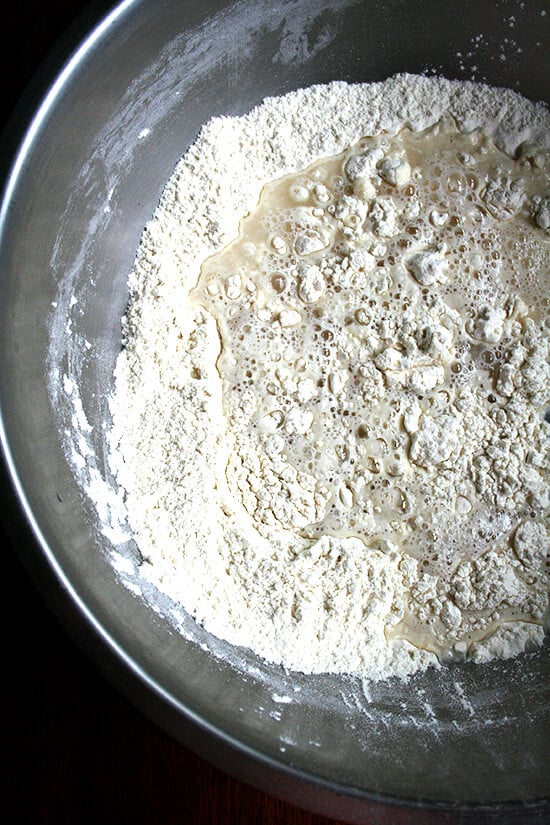
Mix until you have a sticky dough ball. Let it rise for 1.5 to 2 hours…
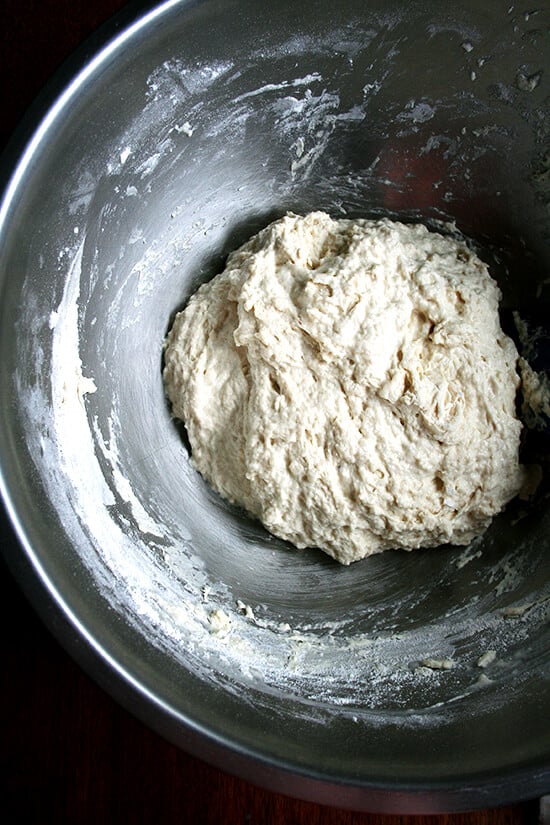
… or until it looks like this:
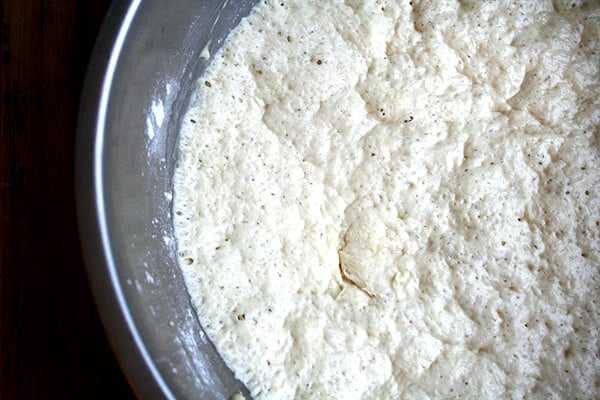
Punch down the dough using two forks.
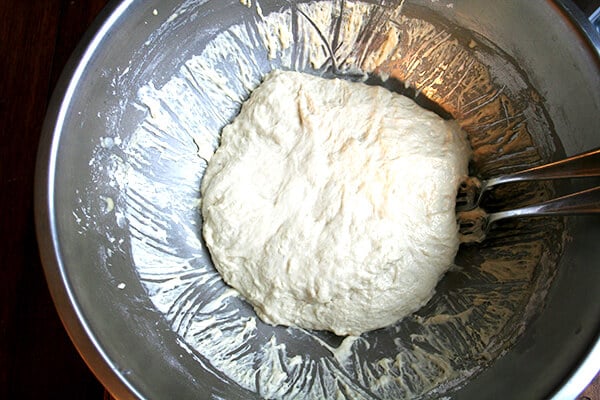
Then split the dough down the middle again using the two forks.
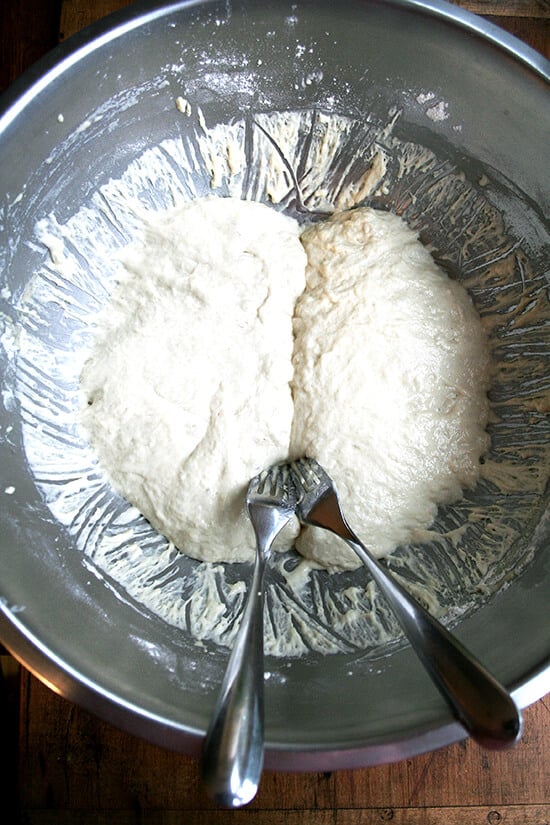
Because this is a very wet dough, it must be baked in an oven-proof bowl. I am partial to the Pyrex 1L 322 size, but any similarly sized oven-proof bowl will work.
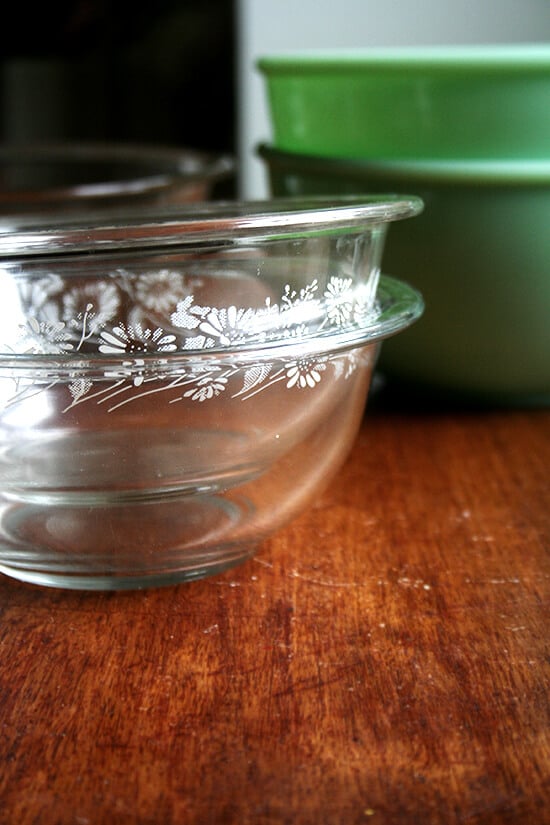
Butter the bowls well; then transfer half of the dough to each prepared bow.
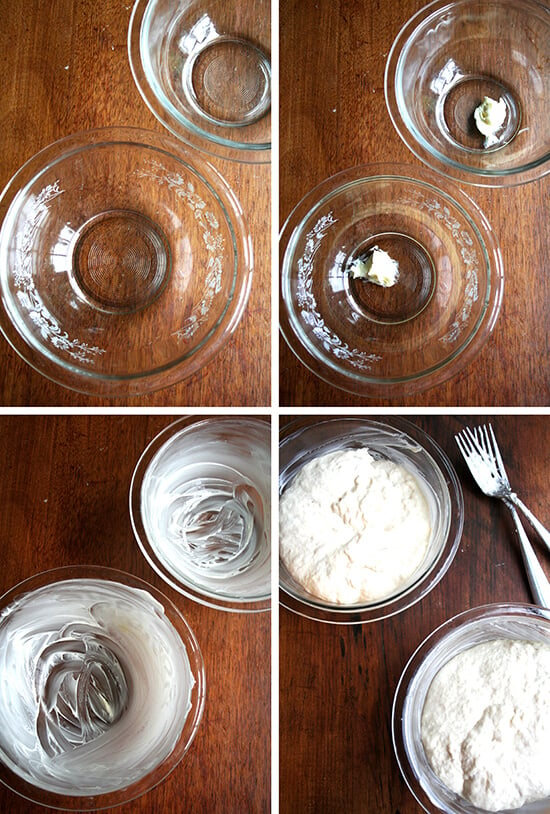
Let the dough rise again until it crowns the rim of the bowl, about 30 minutes.
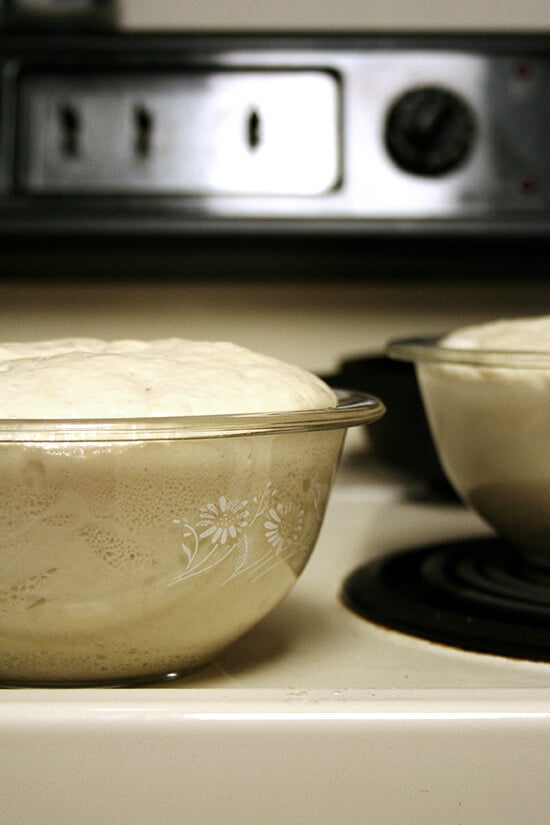
Transfer the bowls to the oven to bake:
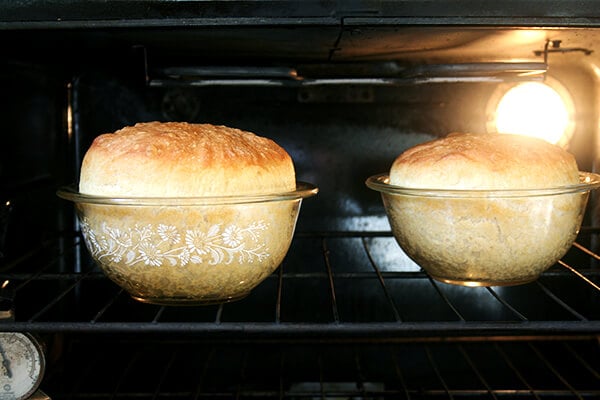
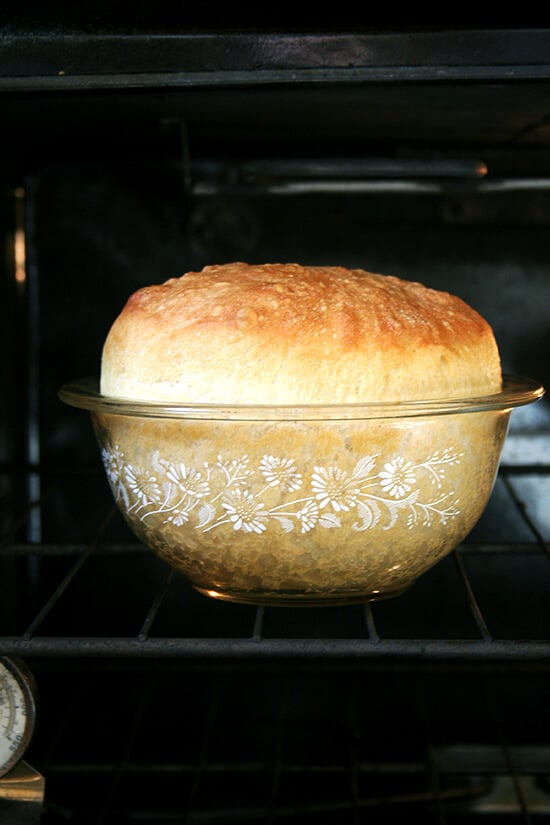
This bread is irresistible when it’s freshly baked, but it also makes wonderful toast on subsequent mornings as well as the best grilled cheese. It’s also my favorite bread to use for these egg salad sandwiches and for this no-tuna “tuna” salad.
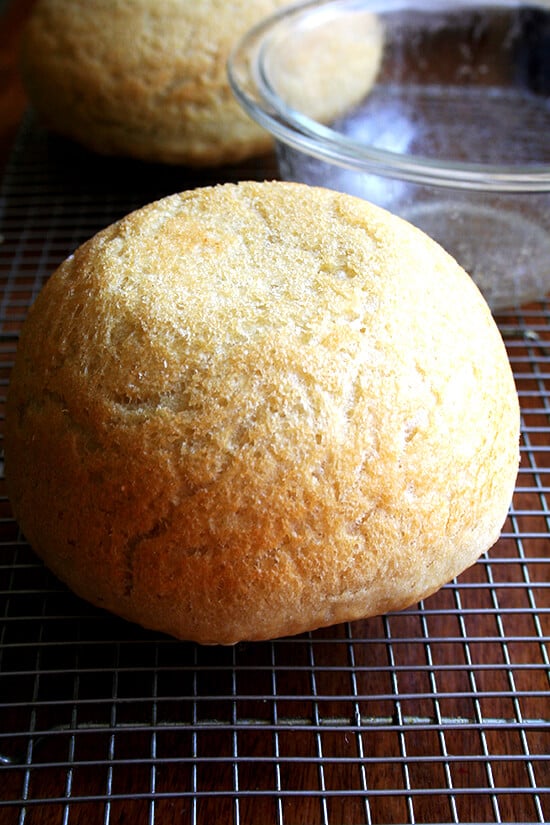
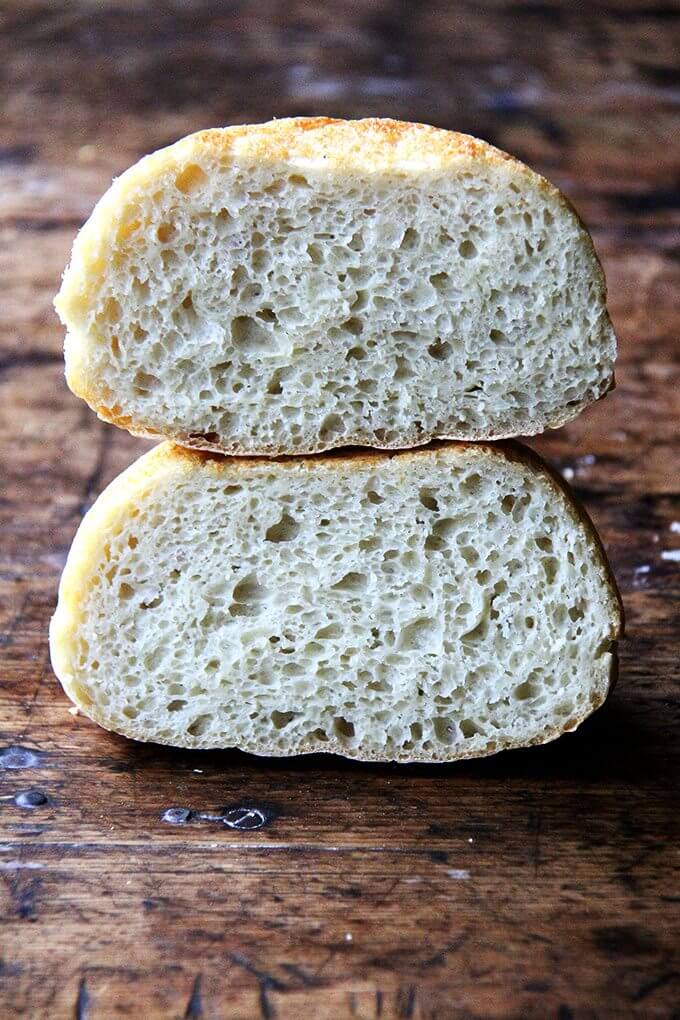
The Best Way to Store Bread
If you want to store the bread at room temperature for 3 to 4 days, I think the best method is in a ziplock bag. I’ve tried other eco-friendly options, but nothing seems to keep bread freshest — the crumb the softest — better than a ziplock bag. You can re-use the bags again and again.
If you intend to keep the bread for longer, I would freeze it. I often slice bread as soon as it cools completely, transfer the slices to a ziplock bag, then freeze. This way, I know the bread was frozen at its freshest.
A ziplock bag will not prevent the crust of bread from turning soft, which is why I suggest always reheating day-old bread. I use a toaster at breakfast for slices of bread, and I reheat half or quarter loaves in the oven at 350ºF for 15 to 20 minutes when serving for dinner.
Bread revives so beautifully in the oven or toaster.
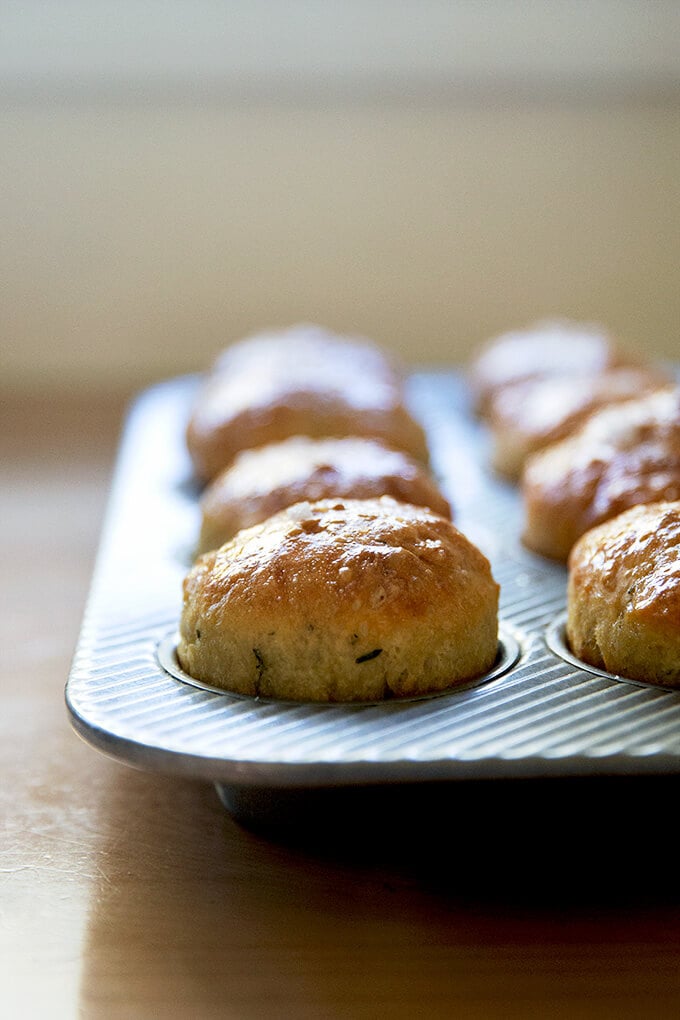
No-Knead Dinner Rolls
To use the peasant bread dough to make rolls, simply divide the dough into smaller portions and place in a buttered muffin tin as in these No-Knead Thyme Dinner Rolls (pictured above). This recipe for no-knead buttermilk pull-apart rolls is also based on the peasant bread as are these brioche pull-apart rolls.
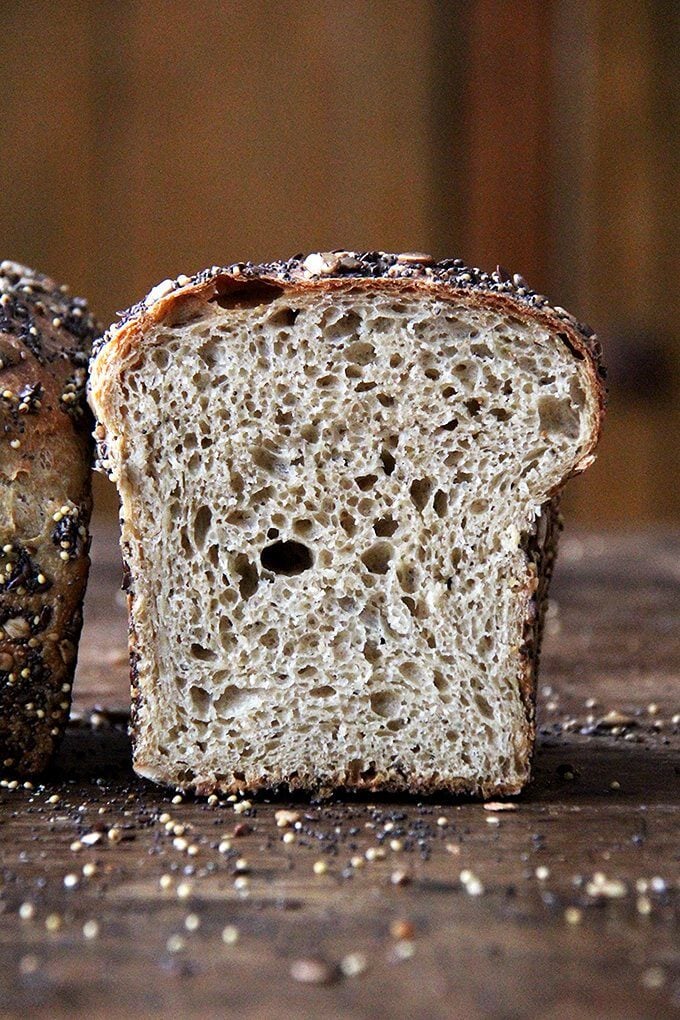
No-Knead Sandwich Bread
To make sandwich bread, multiply the recipe below by 1.5 and bake the bread in two buttered 8.5×4.5-inch loaf pans.
Made with half all-purpose flour and half King Arthur Sprouted Wheat Flour, these seed-coated sandwich loaves (pictured above) have a soft and light crumb. I really like KAF’s sprouted wheat flour, which is made from white whole wheat berries that, when sprouted, yield a creamy, sweet, milder-tasting flour. You can use 100% all-purpose or bread flour for an even lighter loaf or your favorite whole wheat flour in place of the sprouted wheat flour.
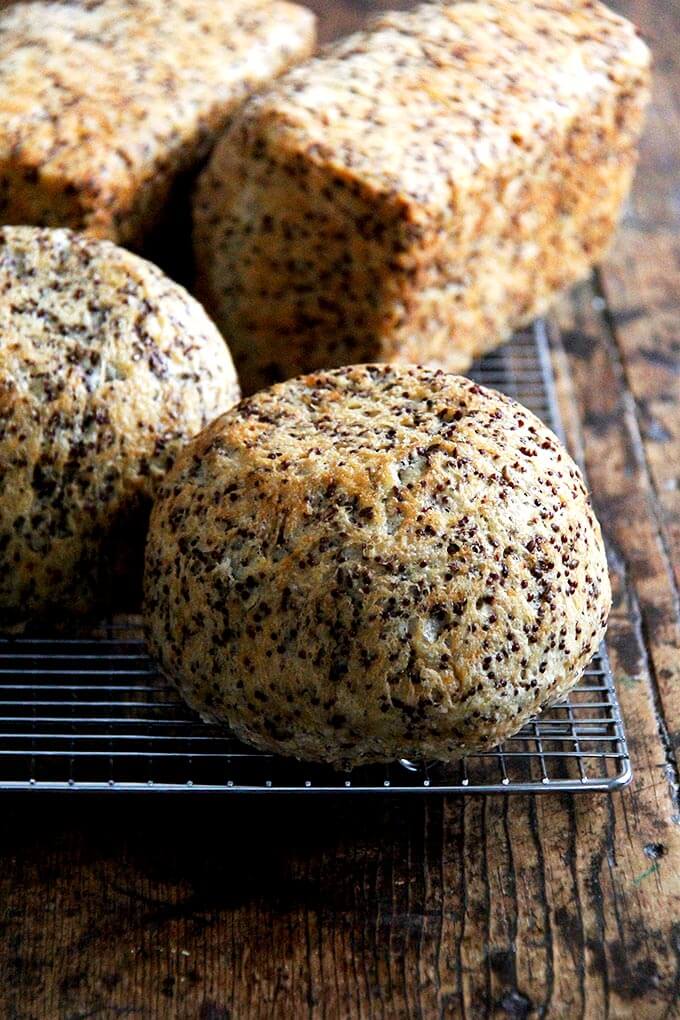
How to Add Nuts and Seeds to Bread Dough
To add seeds and nuts (or dried fruit and cheese), simply stir them into the dry ingredients. This recipe for Quinoa-and-Flax Toasting Bread will offer guidance on how much to add.
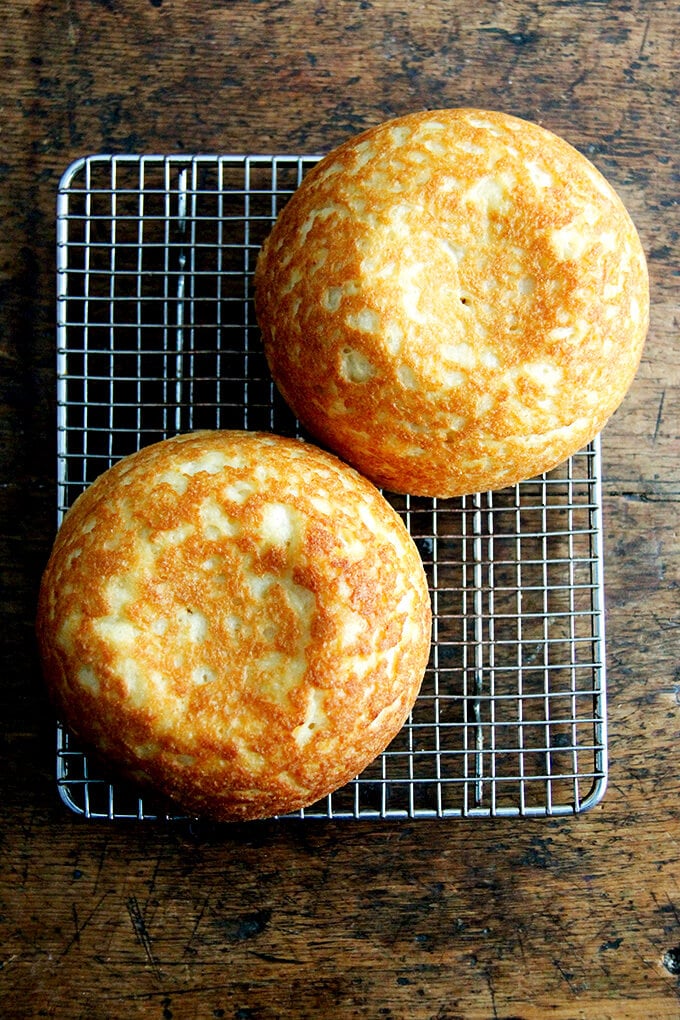
How to Make a Gluten-Free Peasant Bread
Making gluten-free peasant bread (pictured above) unfortunately isn’t as simple as swapping in gluten-free flour for the wheat flour. But the process and recipe is still super simple — in fact, because there’s only one rise, many people find the gluten-free peasant bread to be even simpler than the original. Find the recipe here: Gluten-Free Peasant Bread
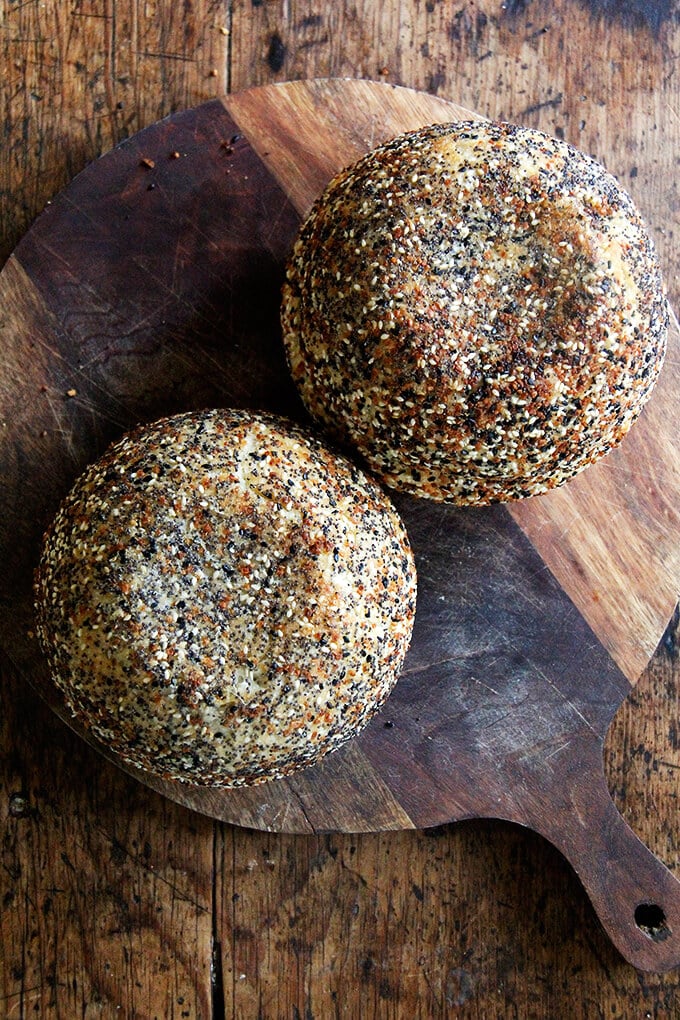
How to Coat the Loaves in Seeds
To coat the peasant bread in seeds, as pictured above, simply coat the bowls with everything bagel seasoning or with dukkah or sesame seeds or whatever seed mix you wish. The seed-coated loaves look so beautiful, and it’s amazing how much the flavor of the coating permeates the loaves. Find the recipe here: Everything Bagel Seasoning Peasant Bread
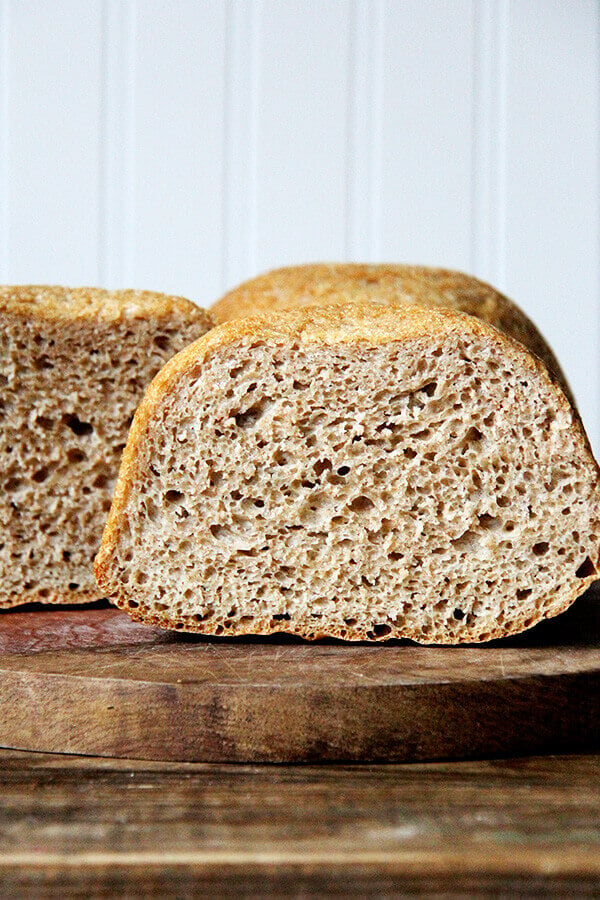
How to Use Whole Wheat Flour
To use whole wheat flour in the peasant bread, simply replace as much as 50% of the all-purpose flour with your favorite whole wheat flour: I like KAF’s sprouted wheat flour, and I’ve been loving the Cairnsprings Mill Trailblazer stone-milled flour. With the Trailblazer, I can use up to 75% of it in the peasant bread, and it yields a beautiful, chewy texture as well as a lovely flavor and aroma.
When using whole wheat flour, you may have to use more or less water — there is no rule as to how much more or less, and it will take some trial and error to get right because all flours absorb water differently. When I use KAF sprouted wheat flour, for example, I don’t change the water amount at all. When I use the Trailblazer flour, on the other hand, I reduce the water by at least 50 grams.
If you’d like to learn more about whole wheat flour and stone-milled flours, read this: Easy Sourdough Bread (Whole Wheat-ish)
How to Bake the Peasant Bread in a Dutch Oven
If you’re looking for more of a crackling crusted boule (characteristic of a loaf of sourdough bread) as opposed to the buttery crispness of the peasant bread, you can bake the peasant bread dough in a preheated Dutch oven.
There are detailed instructions below the recipe in the notes section, but one thing to keep in mind before you begin is dough hydration. The peasant bread is a very high hydration dough, meaning there is a lot of water relative to flour. Because baking the peasant bread in a Dutch oven will require some handling of the dough — to shape it into a round and to create some tension — you may want to reduce the water from the start. Consider holding back 20-30 grams of water to make the process more manageable for you.
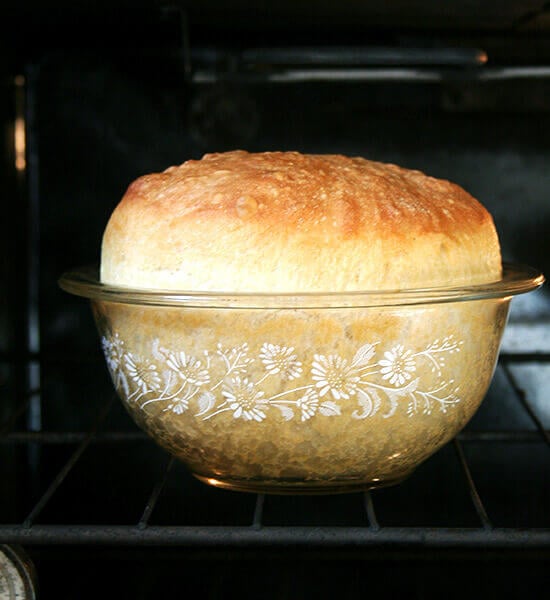
My Mother’s Peasant Bread: The Best Easiest Bread You Will Ever Make
- Total Time: 2 hours 27 minutes
- Yield: 2 loaves
Description
Notes:
The bread:
This is a sticky, no-knead dough, so, some sort of baking vessel, such as pyrex bowls (you need two 1-qt bowls) or ramekins for mini loaves is required to bake this bread. See notes below the recipe for sources. You can use a bowl that is about 2 qt or 2 L in size to bake off the whole batch of dough (versus splitting the dough in half) but do not use this size for baking half of the dough — it is too big.
Peasant Bread Fans! There is now a book: Bread Toast Crumbs, a loaf-to-crumb bread baking book, filled with tips and tricks and answers to the many questions that have been asked over the years. In the book you will find 40 variations of the master peasant bread recipe + 70 recipes for using up the many loaves you will bake. Learn more about the book here or buy it here.
Ingredients
- 4 cups (512 g) unbleached all-purpose or bread flour
- 2 teaspoons (10 g) kosher salt
- 2 cups (454 g) lukewarm water (made by mixing 1.5 cups cold water with 0.5 cup boiling water)
- 2 teaspoons (8 g) sugar
- 2 teaspoons (8 g) instant yeast, I love SAF Instant Yeast, see notes below
- room temperature butter, about 2 tablespoons
Instructions
- Mixing the dough: In a large mixing bowl, whisk together the flour, salt, sugar, and instant yeast (I love SAF Instant Yeast). Add the water. Mix until the flour is absorbed. (If you are using active dry yeast, see notes below.)
- Let it rise. Cover bowl with a tea towel or plastic wrap and set aside in a warm spot to rise for at least an hour. (In the winter or if you are letting the bread rise in a cool place, it might take as long as two hours to rise.) This is how to create a slightly warm spot for your bread to rise in: Turn the oven on at any temperature (350ºF or so) for one minute, then turn it off. Note: Do not allow the oven to get up to 300ºF, for example, and then heat at that setting for 1 minute — this will be too hot. Just let the oven preheat for a total of 1 minute — it likely won’t get above 100ºF. The goal is to just create a slightly warm environment for the bread.
- Preheat the oven to 425ºF. Grease two 1-qt or 1.5-qt oven-safe bowls (see notes below) with about a tablespoon of butter each. Using two forks, punch down your dough, scraping it from the sides of the bowl, which it will be clinging to. As you scrape it down try to pull the dough toward the center (see video below for guidance). You want to loosen the dough entirely from the sides of the bowl, and you want to make sure you’ve punched it down. Then, take your two forks and divide the dough into two equal portions — eye the center of the mass of dough, and starting from the center and working out, pull the dough apart with the two forks. Then scoop up each half and place into your prepared bowls. This part can be a little messy — the dough is very wet and will slip all over the place. Using small forks or forks with short tines makes this easier — my small salad forks work best; my dinner forks make it harder. It’s best to scoop it up fast and plop it in the bowl in one fell swoop. Some people like to use flexible, plastic dough scrapers for this step.
- Let the dough rise again for about 20 to 30 minutes on the countertop near the oven (or near a warm spot) or until it has risen to just below or above (depending on what size bowl you are using) the top of the bowls. (Note: Do not do the warm-oven trick for the second rise, and do not cover your bowls for the second rise. Simply set your bowls on top of your oven, so that they are in a warm spot. Twenty minutes in this spot usually is enough for my loaves.)
- Bake it. Bake for 15 minutes. Reduce the heat to 375º and bake for 15 to 17 minutes longer. Remove from the oven and turn the loaves onto cooling racks. If you’ve greased the bowls well, the loaves should fall right out onto the cooling racks. If the loaves look a little pale and soft when you’ve turned them out onto your cooling racks, place the loaves into the oven (outside of their bowls) and let them bake for about 5 minutes longer. Remove from oven and let cool for 10 minutes before cutting.
Notes
- The bowls: The cheapest, most widely available 1-qt bowl is the Pyrex 322. Update: These bowls are becoming harder to find and more expensive. As a result, I’m suggesting this cheaper option: the Pyrex 3-piece set. You can split the dough in half as always (see recipe) and bake half in the 1-quart bowl and half in the 1.5 quart bowl. The loaves will not be the same shape, but they will be delicious nonetheless.
- Yeast: I buy SAF Instant Yeast in bulk from Amazon I store it in my fridge or freezer, and it lasts forever. If you are using the packets of yeast (the kind that come in the 3-fold packets), just go ahead and use a whole packet — It’s 2.25 teaspoons. I have made the bread with active dry, rapid rise, and instant yeast, and all varieties work. The beauty of instant yeast is that there is no need to “proof” it — you can add the yeast directly to the flour. I never use active-dry yeast anymore.
- If you have active-dry yeast on hand and want to use it, here’s how: In a small mixing bowl, dissolve the sugar into the water. Sprinkle the yeast over top. There is no need to stir it up. Let it stand for about 10 to 15 minutes or until the mixture is foamy and/or bubbling just a bit — this step will ensure that the yeast is active. Meanwhile, in a large bowl, whisk together the flour and salt. When the yeast-water-sugar mixture is foamy, stir it up, and add it to the flour bowl. Mix until the flour is absorbed.
- Troubleshooting: You can find step-by-step video instruction here.
- Several commenters have had trouble with the second rise, and this seems to be caused by the shape of the bowl they are letting the dough rise in the second time around. Two hours for the second rise is too long. If you don’t have a 1-qt bowl, bake 3/4 of the dough in a loaf pan and bake the rest off in muffin tins or a popover pan. The second rise should take no more than 30 minutes.
- Also, you can use as many as 3 cups of whole wheat flour, but the texture changes considerably. I suggest trying with all all-purpose or bread flour to start and once you get the hang of it, start trying various combinations of whole wheat flour and/or other flours.
- The single most important step you can take to make this bread truly foolproof is to invest in a digital scale. This one costs under $10. If you are not measuring by weight, do this: scoop flour into the measuring cup using a separate spoon or measuring cup; level off with a knife. The flour should be below the rim of the measuring cup.
- Here’s a printable version of this recipes that’s less wordy: Peasant Bread Recipe, Simplified
- How to Bake the Peasant Bread in a Dutch Oven: Preheat a Dutch Oven for 45 minutes at 450ºF. Dust a clean work surface with flour. After the first rise, turn the dough out onto the floured surface and shape it into a ball: I like to fold it envelope style from top to bottom, then side to side; then I flip it over and use the pinkie edges of my hands to pinch the dough underneath and create some tension. Transfer the dough to a sheet of parchment paper. Let rest for 20 minutes. If you feel your dough is spreading too much you can lift up the sheet of parchment paper, dough and all, and place it in a bowl of a similar size. After the 20 minutes, transfer the dough, parchment paper and all to the Dutch oven. Carefully cover it. Bake 30 minutes. Uncover. Bake 15 minutes more.
- To bake the peasant bread in a loaf pan: If you are using an 8.5×4.5-inch loaf pan or a 9×5-inch loaf pan, you can bake 3/4 of the dough in it; bake off the rest of the dough in ramekins or other small vessels … the mini loaves are so cute. You can also make 1.5x the recipe, and bake the bread in 2 loaf pans. If you have a large loaf pan, such as a 10×6-inch loaf pan, you can bake off the entire batch of dough in it. For loaf pans, bake at 375ºF for 45 minutes.
- How to Bake at Hight Altitude:
- First try the original recipe as written (preferably with a scale). You may not need to make any adjustments. One commenter, who lives at 9200 ft finds the original recipe to work just fine as is.
- If the original recipe doesn’t work, try adding a little bit more water because it rises fast and it is so dry: about a quarter cup for every 512 g of flour.
- Try decreasing the yeast to 1.5 teaspoons.
- If your dough is especially gooey, try decreasing the water by 1/4 cup. But, if you aren’t using a scale, my first suggestion would be to buy a scale and weigh the flour, and make the bread once as directed with the 2 cups water and 512 grams flour, etc.
- Punch the dough down twice before transferring it to the buttered Pyrex bowls. In other words, let it rise for 1-1.5 hours, punch it down, let it rise again for about an hour, punch it down, then transfer it to the buttered bowls.
- Variations:
- #1. Cornmeal. Substitute 1 cup of the flour with 1 cup of cornmeal. Proceed with the recipe as directed.
- #2. Faux focaccia. Instead of spreading butter in two Pyrex bowls in preparation for baking, butter one 9×9-inch glass baking dish and one Pyrex bowl or just butter one large 9×13-inch Pyrex baking dish. If using two vessels, divide the dough in half and place each half in prepared baking pan. If using only one large baking dish, place all of the dough in the dish. Drizzle dough with 1 tablespoon of olive oil (if using the small square pan) and 2 tablespoons of olive oil (if using the large one). Using your fingers, gently spread the dough out so that it fits the shape of the pan. Use your fingers to create dimples in the surface of the dough. Sprinkle surface with chopped rosemary and sea salt. Let rise for 20 to 30 minutes. Bake for 15 minutes at 425ºF and 17 minutes (or longer) at 375ºF. Remove from pan and let cool on cooling rack.
- #3. Thyme Dinner Rolls
- #4 Gluten-free
- #5. Everything Bagel Seasoning Bread. Simply coat the buttered bowls with Everything Bagel Seasoning. Watch a how-to on Instagram Stories here.
- #6: Whole Wheat Peasant Bread. Use as much as 50% whole wheat flour. I like King Arthur Flour’s white whole wheat flour (see this post) or sprouted wheat flour (see this post).
- Prep Time: 5 minutes
- Cook Time: 32 minutes
- Category: Bread
- Method: Baked
- Cuisine: American
This post may contain affiliate links. Please read my disclosure policy.

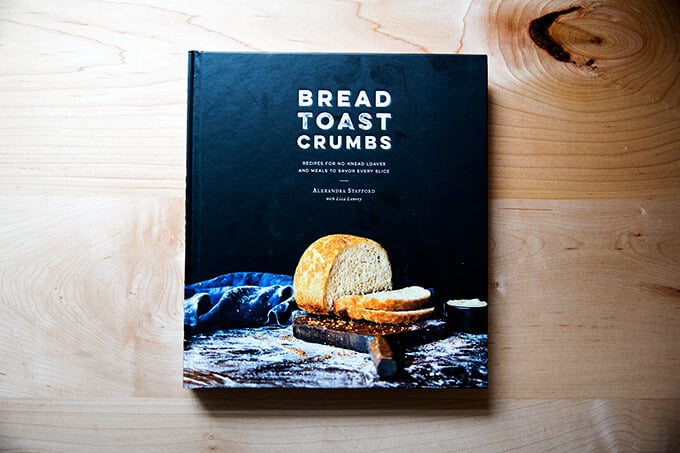
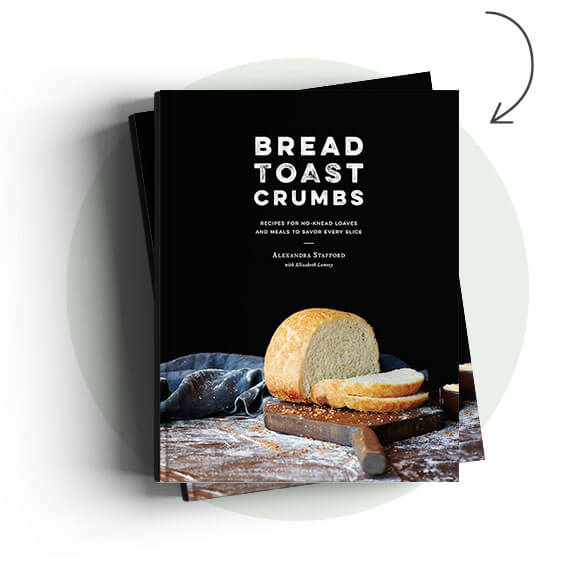

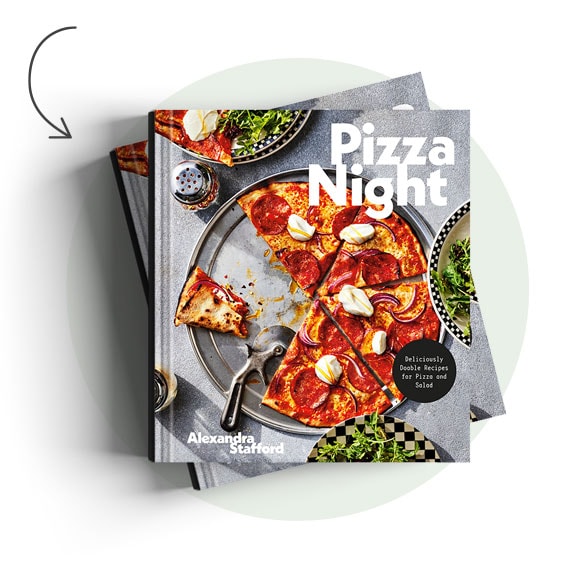

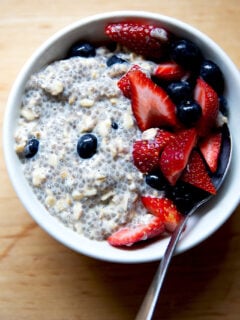
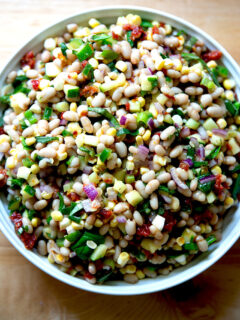
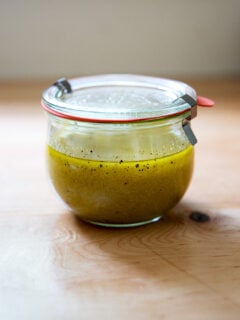
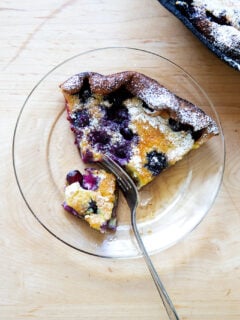


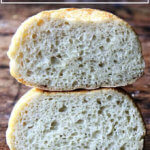
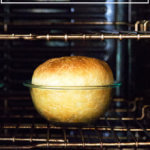
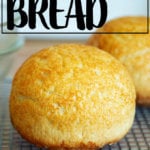
6,377 Comments on “My Mother’s Peasant Bread: The Best Easiest Bread You Will Ever Make”
Hey again!
I use Fleishmans active dry and store it in my fridge. The dough doubles on the first rise (sits for an hour), and I have done the warm oven thing both times. On the second rise I have let the bowls sit on the stove while the oven heats. Is it possible the yeast is too warm?
Thanks so much for your quick response! Im going to try the bread again tonight to see if I get a higher loaf. Fingers crossed!
Katie — Gosh, it sounds as though you are doing it all right. I can’t see where a problem would arise. My only thought (and I am probably getting to you too late tonight…I hope your batch tonight turned out well) is to try letting the dough rise for a little bit longer on the first time around — like maybe an hour and half or so. And then, still let the bowls sit on the oven while it heats up, but don’t do the oven trick the second time around. I have no real method to my madness here, but I’m just trying to think about what I do versus what you do. Oh also, and I can’t remember if we’ve already discussed this, but what size bowls are you using? If they are a little bit larger than mine, then it makes sense that the loaves will be a little bit squatter. Good luck with it! I am happy to hear you are still experimenting.
Hi! I followed the recipe to the letter and the bread did not rise the second time. In fact, it was barely 1/2 way up the bowl. I let it rise on a preheated oven. What is the problem? I would love to try the recipe again. Thanks!
Daff — several commenters have had trouble with the second rise, and I while I don’t have a definite answer, I am thinking that the trouble is happening with the first rise. Even if you are letting it rise in a warm oven, it is still colder overall this time of year, and I’m thinking if you let the dough rise for 1.5 hours to 2 hours the first time around, you will have better luck with the second rise. I made a batch this afternoon, and I let it rise in the warm oven (preheated for a minute and then turned off) for about two hours so the dough was really fragile and jiggly when I gently shook the bowl. My second rise happened just as usual (if not a little faster) and the dough had crept above the bowl before I put them in the oven. I do hope you give it another try! When it turns out, it is such a wonderful treat!
After 5 years of searching for the perfect easy and delicious everyday bread recipe, this recipe brought my search to an end! I tried bread in 5 minutes a day, but i just don’t love the flavor. I made the NY times no-knead recipe but while easier, it is not easy and it does not keep for more than a day or so. I tried the no knead oatmeal bread on this website, and its great for breakfast with peanut butter, but it is a little too sweets and the texture doesn’t make for great sandwich bread. This bread is perfect. I make a double batch once a week and freeze the extra loaves (which freeze beautifully). Then we take them out whenever we need bread. No more expensive store bought bread. Thank you so much for sharing!
Jen — I am so happy to hear this. And I totally agree with you on your thoughts on the other breads as well as the no-knead oatmeal bread on this site — it is not a great sandwich bread, best used at breakfast for sure. And I am so happy to hear you are using the freezer as well — my mother’s is always full of this bread already sliced ready for sandwiches and toast.
Came out perfect!!! So delicious, great texture! Thanks for the share.
I made this tonight with my girls! Loved it, probably didn’t raise as much as it should. Of course I left to look at Christmas lights and came back later than expected. The girls loved the flavor and they were so excited to punch it! Thank you for sharing! 🙂
Tina — so happy your girls loved it and the experience of punching the dough. A number of people have had trouble with getting it to rise as high. I am perplexed and want to get to the bottom of it!
Hi! I’m trying this recipe today…sure am excited! Question though…what is the difference between making it with bleached all purpose vs. All purpose flour? I’m looking in my pantry and all I have is bleached. Will it not work at all? Thanks!!!
Shannon — the bread will still turn out ok, but there is something about the bleached flour that affects the texture and flavor, and I’m not sure why. I’ve made the bread twice now with bleached flour and have been disappointed in the final loaves. I noticed, too, that I had to let the bread rise a little bit longer on the first round (closer to two hours) and the final color of the loaves just wasn’t as golden.
It still makes nice toast, but it definitely is a different final product. It might be worth trying just so you can do a test-run with the process, but if you have the patience to wait till you get to the store next, that might be best 🙁
it definitely did rise both times but went crispy and tasted a little greasy, is this because I used a vegetable based butter substitute and should I try it with a floured bowl instead?
Gosh, Samantha, I don’t know. The crust of the bread definitely is crispy, which I love, and also a little greasy — it has a nice butter flavor. I’m not familiar with butter substitutes, but I would suggest olive oil over flour — I think the flour will burn, and the bread will stick.
I tried this for the first time today and followed everything that you said. I used the Fleischmann’s rapid rise yeast. I left it raise for about 2 hours for the first raise (near a warm oven while I was baking other things), and then for over an hour on the 2nd raise (again on the warm oven). The 1st raise it doubled, but the 2nd raise barely at all. It looked like lumpy mashed potatoes, and ended up coming out a very stiff, solid bread. I used the 2.5 qt pyrex bowls like you did as well. Not sure what went wrong!?
Dana — I am stumped. I am not surprised about the final loaf tasting stiff and solid if it didn’t rise much, but I am surprised about the second rise not working out. Did you in fact use the 2.5-qt bowl? Because I use a 1L (1-qt) bowl, which might make a difference. Because the dough is very fragile, a smaller, not-too-wide bowl works best for the second rise and for baking. I wish I could help more. Several people have had trouble with the second rise, and I am perplexed.
I am doing this RIGHT now and had to run over here and post a progress report.
Everything went just according to plan…the way you posted it.
I just lowered the oven temp (and since I am baking in both a glass bowl and cute lil’ ramekin’s, I turned them at this time, too.
Well, I am SO excited. It smells and looks heavenly.
I did not use forks to divide my dough (I just can NOT stand the sound of forks scraping…on anything…and just the thought of all those tines scraping…. *shivers*)… so instead, I just used my spatula and it worked out perfectly fine.
Just scooped up what I needed to fill each buttered covered bowl, lol!
Oh yea, and I loved the yeast tip, too about boiling the hot water and adding to the cold. I used it!
Thanks for the great blog post…..hope i can wait for my little bread bunnies to cool! nom-nom! 🙂
Laney — SO happy to hear this. I just want everybody to have these results. Can you report back post dinner when you get a chance? And I do know what you mean about the forks…glad the spatula worked out for you 🙂
OMG!!! I have been baking a no knead bread I found on Pinterest for months now and I’m so excited to have found this one!!!:)) It looks like allot of people are having problems with the second rise may I suggest pouring hot water in the second rise bowls/pans, let set for maybe 5 min. empty and dry well, brush with the olive oil or butter then add the dough and let rise. Sometimes cold utinsels are just a little to cold for the products, speaking from many trials and errors myself. On the way to the kitchen to test this bread…so excited….thank you sooooo much
Barbara — thank you for that tip! I am truly stumped about the second-rise issues. Let me know now this turns out for you!
Easy and delish!
Hi Alexandra! Just wanted to say that I randomly found your site but am SO glad that I did. I’ve been making this peasant bread now for a few weeks (sometimes twice a week) so that we have fresh bread for breakfast and lunch. My husband likes a slice of this bread toasted on a skillet with an egg and slice of cheese for breakfast – it’s delicious all warm and melted. Thank you for starting and sharing such a wonderful collection of recipes and photos!
Semper Fi,
Ashley
Ashley, that breakfast sounds absolutely divine! I love the idea of toasting bread in a skillet and I don’t do it enough. Thank you for your nice words about the blog, and I am so happy you have had success with the bread. It’s one of my faves. Semper Fi to you as well!
I still can’t believe it, I made bread!! I am a bread baker. And I had no patience, did not wait like I should have for the bubbling, or let it rise one second past one hour, and they still turned out amazing. Holy cow, thank you 🙂
Libby and Tonia — so happy to hear this! I just wish everyone would have these same results. Happy Holidays!
Have made your recipe twice now – I absolutely love it, it’s so easy to throw together.
My two loaves are in the oven now. We can hardly wait to slather in butter and strawberry jelly tonight for a snack! I had no problems whatsoever with the second rise. I’ll let you know how it turns out. Thanks so much for posting such an easy recipe to follow!
Okay, first off the bread is delish!!! However, next time I need to really really butter the dishes because the loaves stuck and I had to really work to get them out. Secondly, the tops were a beautiful, deap golden color but not cooked enough on the inside. So as you suggested, on the second loaf (cuz the first one was gobbled down), I put it on my cookie sheet face down and cooked for another 5 min. I will master this recipe by making again!!!! Than you!
Juenessa — Yes, this is true — slathering with butter is sort of necessary to prevent sticking. It also helps make a delicious crispy crust. Next time you make the bread, try these baking times: 15 minutes at 425ºF, 17 minutes at 375ºF — I have found this creates a nicer golden crust as well as a more evenly cooked inside. Let me know how the second time around goes!
Hi! This recipe looks wonderful! Would this be a good bread to accompany pasta? Thank you!
AShley — definitely! It’s a good bread to accompany anything.
I just made this an it was sooooo great! but as everyone else is saying my second rise just didnt go as high as the first and I even let the second batch rise for 2+ hours to see If it might. I tried to read the other posts but didn’t see a great answer…. but here is my thought/question. I used a larger bowl, do you think the dough is too heavy and sticky to rise (the second time) In a larger bowl?
As I’m typing this my other loaf just came out of the oven and it did rise a little more than the first but it fell in in the middle….???
I’m going to test using different bowls and see if that has anything to do with it. I also am thinking my oven temp might be to blame. too hot or cold? any good ideas anyone??
thanks for the recipe!
Ashley r — I think what you are suspecting has been the biggest culprit with the second rise. After the dough is split in half, it really needs a small bowl to make that second rise go smoothly. Two hours, a time period which many of the other commenters have waited too, is definitely long enough (too long probably) for the bread to complete the second rise. What size bowl did you use? I think anything larger than 2 quarts is too big. I have a feeling your oven is OK. As long as it’s in the 400ºF range, that’s hot enough for the bread to cook properly. I know bed bath and beyond sells pyrex bowls in sets of three (kind of annoying that you have to buy all three) and that the smallest bowl is the one (I think!) that I use. I also, and this is kind of crazy, buy them on Ebay every so often — I just search for Pyrex 322 1L — if I see a good deal. Hope that helps!
Ashley r, many things could have contributed to your failed bread attempt. Humidity plays a huge part in whether yeast dough will rise properly. Also..too cool temps surrounding the rising bread will also hinder its rise.
When baked bread falls in the center, that means it isn’t done. It needed more time to bake. You should be able to thump the bread and it feel very firm to the touch before you remove it from the oven.
Keep trying. I suggest you try warming the oven slightly and turn it off and place the rising bread in that oven for the allotted time. Practice does make perfect and soon you’ll be turning out fabulous bread!!
Lyn — thanks for your help with this!
Is there a specific reason to not use bleached all-purpose flour?
Courtney — I just have not had good results with bleached flour. I almost always use King Arthur all-purpose, but I have a bag of bleached flour on hand that I am working my way through bc it was all that the store had one day. Twice I’ve tried to make this bread recipe with it, and it just did not turn out well. There is something about the bleached flour that affects the texture and flavor, and I’m not sure why, but I have been disappointed in the final loaves. I noticed, too, that I had to let the bread rise a little bit longer on the first round (closer to two hours) and the final color of the loaves just wasn’t as golden.
It still makes nice toast, but it definitely is a different final product. It might be worth trying just so you can do a test-run with the process, but if you have the patience to wait till you get to the store next, that might be best. I hope that helps!
I have made this recipe several times with different additives and it’s always been a hit. Even with my temperamental oven it comes out beautifully every time. Thank you so much for sharing this recipe!
Brittany — So happy to hear this!
thanks great tips!
my bowl was a 2.5…I’m afraid just too big. I was thinking of trying muffin pans for rolls. I’ll see if it goes any differently. Thank you both for your response! I’m still eating my sad loaf and it tastes great, just not very pretty. I also agree I think 2 hours on the second rise was too long, it changed the texture of the final bread.
I’ll report back if I figure it out!
Have a merry Christmas!
Ashley r — Merry Christmas to you as well! I think you will have great success with the muffin tins or buttered ramekins if you have a set. Hope the next batch turns out well!
Made it the first time and it was great. Second time… Even better. The third time I just added some sprinkles of dried rosemary and holy cow!!! I have so many ideas now for simple gifts that are homemade and delicious! Thanks so much.
Can you use a metal loaf pan to bake these?
Jessica — you can, you just might not be able to fit all of the batter in one pan. I would do 3/4 batter in loaf pans and then make mini loaves in ramekins or muffin tins. Be sure to butter everything really well!
I love making this bread, it’s so simple and delicious. I use all whole wheat flour for mine and it comes out really moist and chewy.
Fa — wonderful to hear this!
Have you made the bread in ramekins or muffin tins? How did you adjust the time and temp?
Teak — for ramekins and muffin tins: make sure you grease very well with butter and bake them for about 10 minutes at 425 and another 10 to 15 minutes at 375. Hope that helps!
the 1 1/2 c. cold water to 1/2 c. boiling water wasn’t hot enough, my yeast didn’t foam and the bread didn’t rise very good, I
tried 1 c. cold and 1 c. boiling and it worked perfectly and rose very fast, just letting you know what happened with me.
This bread is fantastic! My husband and I love it and I’ve already made it twice 🙂 Keep up the great recipes!
Leah — wonderful to hear this! Happy New Year!
I made this tonight and mine looked NOTHING like yours. 🙁 I thought I following the recipe and directions exactly. My end result was more of a dense, heavy brick. 🙁
I am an experienced baker but this was fun to make for a quick bread for Christmas.Thanks for sharing.